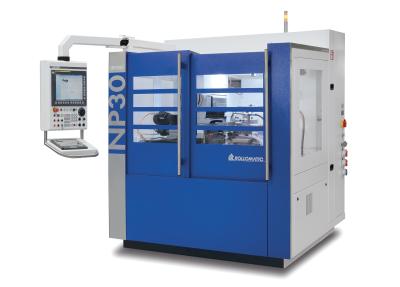
Rollomatic, a leading machine tool manufacturer based in Le Landeron, Switzerland, maintains its global leadership position in the field of pinch and peel grinding by presenting the ShapeSmart® NP30 which replaces the original NP3+ model. Rollomatic is the original inventor of the pinch/peel grinding methodology and stays in the forefront in developing new models and specific processes related to making these types of machines even more productive.
Pinch grinding offers highest concentricity particularly on long and thin parts. The rough and finish grinding are performed in one pass. This innovative way to grind roughing and finishing simultaneously eliminates a separate process and reduces cycle time. The machine utilizes two different grinding wheels running on separate spindles and positioned on independently‐controlled CNC linear slides.
New Features:
- Both the finish and the roughing station have a separate direct‐drive synchronous spindle motor which provides better stock removal, less induced heat, better surface finish and longer wheel life.
- Redesigned workhead for higher stability during grinding large parts.
- Switch‐over of roughing station from 10˚ to 90˚ within a few minutes.
Existing Features:
- Excellent mirror surface finishes and near‐zero TIR for drill margins can be achieved.
- Repeatable process with tight tolerances and for long‐batch production.
- Both grinding stations are equipped with super‐abrasive wheels with different grit sizes. One wheel carries out the rough grinding, while the other wheel is for finish grinding. The grit sizes and bond compositions are carefully selected to optimize the surface finish to be achieved, and find the right balance between minimal wheel wear and best cycle time.
- A proprietary process that involves mute‐pass grinding and pinch finish grinding is used which has been developed over many years of testing.
- Dimensional tolerances can be maintained over long or short production runs with the help of in‐process measurements. and automatic compensation for wheel wear and for changes in ambient temperature.
Typical Applications:
- Blank preparation for the industrial, orthopedic and dental cutting tool industry
- Grinding of grip attachments (quick‐disconnect) on orthopedic and dental cutting tools
- Core pins for pipettes in the plastic injection molding industry
- Precision punches and cold‐forming tools
- Mold components such as gate valve stems, ejector pins, core pins and more
- Weaponry‐related parts such as firing pins and more
- Precision pins for the electronic, fiber optic and related industries
Both grinding spindles are “synchronous direct‐drive spindles” with 19 hp peak each. The most important feature of a synchronous motor is that it provides constant speed during its operation and that the torque curve is highly efficient, as per above graph. The rotational force is not reduced with higher RPM’s. Synchronous motors always run at a speed equal to their synchronous speed, as opposed to asynchronous motors (induction motors) which always have a lag and are therefore less efficient.
On the many test production runs, the following results were achieved:
- Much quicker set‐up Times.
- With the highest achievable material removal rate and a repeatable process on long‐batch production grinding, the machine outperforms alternative competitive equipment by more than 40%.
- Wheel spindle load on the roughing side (synchronous spindle) was no more than 35%. The limiting factor is the wheel wear and not the machine. The machine will always outperform the wheels.
- The highly efficient synchronous spindles, running at max. 35% power draw or less, do not release any heat into the machine or into the grinding process. This greatly helps with keeping the thermal stability of the machine.
- Synchronous spindles are much quieter even under load compared with induction motors.
- An excellent G‐ratio can be achieved which is the ratio between the stock removal and the wheel wear volume.
- TIR less than 1 micron (provided the blanks are straight to the same tolerance).
- The mirror surface finishes are exceeding the expectations.
Contact Details
Related Glossary Terms
- computer numerical control ( CNC)
computer numerical control ( CNC)
Microprocessor-based controller dedicated to a machine tool that permits the creation or modification of parts. Programmed numerical control activates the machine’s servos and spindle drives and controls the various machining operations. See DNC, direct numerical control; NC, numerical control.
- grinding
grinding
Machining operation in which material is removed from the workpiece by a powered abrasive wheel, stone, belt, paste, sheet, compound, slurry, etc. Takes various forms: surface grinding (creates flat and/or squared surfaces); cylindrical grinding (for external cylindrical and tapered shapes, fillets, undercuts, etc.); centerless grinding; chamfering; thread and form grinding; tool and cutter grinding; offhand grinding; lapping and polishing (grinding with extremely fine grits to create ultrasmooth surfaces); honing; and disc grinding.
- micron
micron
Measure of length that is equal to one-millionth of a meter.
- total indicator runout ( TIR)
total indicator runout ( TIR)
Combined variations of all dimensions of a workpiece, measured with an indicator, determined by rotating the part 360°.

